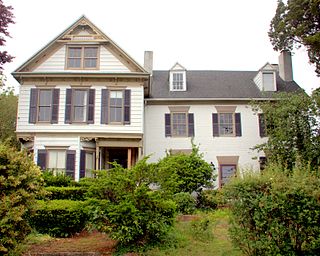
Laurel is a town in Sussex County, Delaware, United States. The population was 3,708 at the time of the 2010 census. Laurel is part of the Salisbury, Maryland-Delaware Metropolitan Statistical Area. It once hosted the Laurel Blue Hens of the Eastern Shore Baseball League.
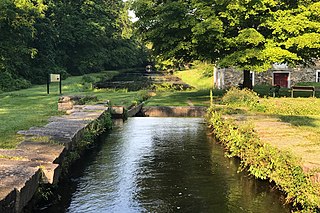
The Morris Canal (1829–1924) was a 107-mile (172 km) common carrier anthracite coal canal across northern New Jersey that connected the two industrial canals in Easton, Pennsylvania across the Delaware River from its western terminus at Phillipsburg, New Jersey to New York Harbor and New York City through its eastern terminals in Newark and on the Hudson River in Jersey City. The canal was sometimes called the Morris and Essex Canal, in error, due to confusion with the nearby and unrelated Morris and Essex Railroad.
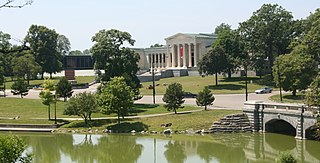
Delaware Park–Front Park System is a historic park system and national historic district in the northern and western sections of Buffalo in Erie County, New York. The park system was designed by Frederick Law Olmsted and Calvert Vaux and developed between 1868 and 1876.
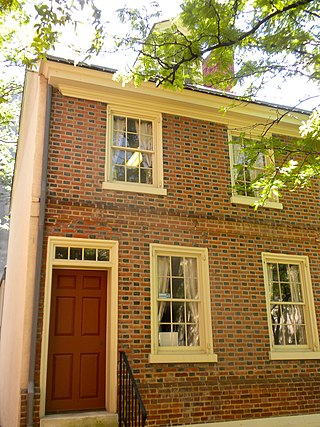
Jacob Dingee House is a historic home located at Wilmington, New Castle County, Delaware. It was built about 1771, and is an example of an 18th-century urban residence continually occupied by working families. It is a two-story, brick dwelling consisting of a 17 feet, 5 inches wide by 24 feet deep main block connected to a 13 feet, 8 inch wide, and 31 feet deep rear wing by a 10 feet wide, 6 feet long connector wing. It is adjacent to the Obidiah Dingee House. In 1976, it was moved from its original location at 105 E. 7th Street to Willingtown Square of the Delaware Historical Society.

The Chipman Potato House was located near Laurel, Delaware, one of the last surviving examples of its building type. The southern part of Delaware saw a sweet potato boom from 1900 until blight struck in the 1940s. In order to store the crops, potato houses were built. The Chipman House was built in 1913 by Joseph and Ernest Chipman on their property with the assistance of Alva Hudson. The 2½ story balloon-framed house was furnished with sparse, shuttered windows and slatted floors, allowing adjustment of air circulation. Two stoves provided heat during the winter, one of which survives.
The Wright Potato House was a small 1+1⁄2-story building near Laurel, Delaware that was built to store harvested sweet potatoes. It was listed on the National Register of Historic Places in 1990.

The Collins Potato House is located near Laurel, Delaware, one of the last surviving examples of its building type. The southern part of Delaware saw a sweet potato boom from 1900 until blight struck in the 1940s. In order to store the crops, potato houses were built. The Collins house was the first to be built in the Little Creek Hundred region and dates to the late 19th century. Measuring 19 feet (5.8 m) by 30 feet (9.1 m), the two-story balloon-frame structure consists of a central aisle flanked by bins on both levels. There are five bins per side. An interior stair provides access to the first floor. Freeze protection was provided by a coal stove. Wall construction is in three layers, with interior planking, sheathing and weatherboard siding. The front elevation on the west side features door at the first and second floors, while the rear elevation has a door at the first floor and a window at the second. Small windows are in both gables for ventilation.

Twentieth Century Club of Lansdowne is a historic club building located at Lansdowne, Delaware County, Pennsylvania. It was built in 1911, and is a 1+1⁄2-story, rectangular stone and brick building measuring 43 feet, 10 inches, by 95 feet, 6 inches. It has a small rear wing, slate pyramid-shaped roof with two projecting front gables, and a large articulated chimney.
Georgetown Coal Gasification Plant, also known as the Georgetown Service and Gas Company, is a historic coal gasification plant located at Georgetown, Sussex County, Delaware. It was built in the late-19th century, and is a rectangular one-story, three bay by three bay brick structure measuring 40 feet by 25 feet. It has a gable roof with a smaller gable roofed ventilator. Also on the property is a small brick gable roofed brick building measuring 8 feet by 10 feet; a small, square concrete building; a large, cylindrical "surge tank;" 500-gallon bottled-gas tank; and a covered pit for impurities. The complex was privately owned and developed starting in the 1880s to provide metered gas for domestic lighting, town street lights, municipal and domestic uses. The coal gasification process was discontinued in the 1940s.

Phillips Potato House is a historic potato house located near Laurel, Sussex County, Delaware. It one of the last surviving examples of its building type. It was built about 1900, and is a two-story, balloon frame structure on a concrete foundation and with a gable roof. It measures 24 feet by 29 feet, and is sheathed in green asbestos shingles over original weatherboards.

Rider Potato House is a historic potato house located near Laurel, Sussex County, Delaware. It one of the last surviving examples of its building type. It was built about 1920, and is a 1+1⁄2-story, gable fronted, balloon frame structure on a brick foundation. It measures 18 feet, 5 inches, by 24 feet 5 inches. It retains a number of important elements characteristic of potato house including: shingled exterior, the quality of second floor paneled interior, ventilation features, and original sliding doors.

Stanley Potato House is a historic potato house located near Laurel, Sussex County, Delaware, United States. It is one of the last surviving examples of its building type. It was built about 1920, and is a 1+1⁄2-story, gable fronted, balloon frame structure on a brick foundation. It measures 17 feet by 23 feet. It retains a number of important elements characteristic of potato house including: minimal fenestration, center aisle floor plan, double siding, and hatched loading doors.

Dickerson Potato House is a historic potato house located near Delmar, Sussex County, Delaware. It one of the last surviving examples of its building type. It was built about 1900, and is a two-story, gable fronted, balloon frame structure on a brick foundation. It measures 30 feet 4 inches by 23 feet 3 inches. It retains a number of important elements characteristic of potato house including: multiple sheathing, gable end orientation, interior chimney, and closely fitting window hatches.
Moore Potato House is a historic potato house located near Laurel, Sussex County, Delaware. It one of the last surviving examples of its building type. It was built about 1920, and is a 1+1⁄2-story, gable fronted, balloon frame structure. It measures 16 feet 6 inches, by 20 feet 4 inches. It retains a number of important elements characteristic of potato house including: tall and narrow proportions, triple siding, minimal fenestration, tightly fitting window hatches, and interior ventilation features.

Ross Point School was a historic rural, African-American school building located near Laurel, Sussex County, Delaware. Funding for the building was provided by Pierre S. du Pont. It was built in 1922, and was a rectangular, one-story wood-frame building in the Colonial Revival style. It had a hipped roof and cedar shingle siding. It had an entrance portico with a triangular pediment. It remained in use as school until September 24, 1964, when it was officially consolidated into the Laurel Special School District.
Robert Davis Farmhouse was a historic farmhouse located near Millsboro, Sussex County, Delaware. It was built about 1900, as a two-story, five-bay, single pile, wood-frame building with asbestos siding. It had a gable roof, with a cross gable and lancet window. Also on the property were two contributing log corn cribs.
Ames Hitchens Chicken Farm was a historic home and farm located near Millsboro, Sussex County, Delaware. It included a two-story, wood frame, gable front dwelling and two long, one-story, flatroofed buildings, used as chicken houses. It was the last of these structures still standing within the Indian River Nanticoke community.
Dodd Homestead was a historic home and farmstead located near Rehoboth Beach, Sussex County, Delaware. It was a modified L-shaped, wood-frame dwelling, the earliest portion of which dated to about 1830. The main house was a long, rectangular, two-story, single-pile structure in a vernacular Federal / Greek Revival style. It had a wing, that was originally one-story. but later raised to a full two stories, probably in the mid-19th century. There was also a two-story rear wing. The house was sheathed in hand-hewn cypress shingles and had stuccoed brick interior end chimneys. Contributing 19th century outbuildings included a low brick ash shed, milk house, wood shed, storage shed, a small shed-roofed poultry house, stable, barn, a large gable-roofed dairy barn, corn crib, and carriage house.
Lawrence was a historic home located in what is now Seaford, Sussex County, Delaware. It was built about 1840 in what was then a rural area, as a three-story, three-bay, frame structure with a gable roof. It has a rear service wing. It featured a front portico supported by four square columns. Original details, including hardware, flooring, trim, and landscaping, survived throughout the house and grounds.
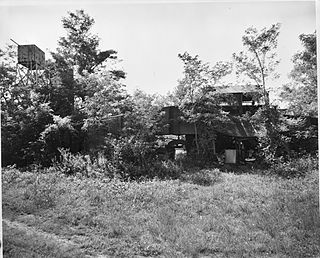
J. H. Wilkerson & Son Brickworks was a historic abandoned brickworks and national historic district located at Milford, Kent County, Delaware. The district includes the sites of three contributing buildings and one contributing site at the brickworks that operated from 1912 to 1957. The sheds, machinery, kiln, and other structures which housed the machinery remain standing, others have deteriorated or collapsed. Last standing were the storage shed, the shed over the brick-making machine, and one of the drying sheds. All of the machinery was in place as were other pieces of equipment used in the brick-making process. The walls of the kiln remain standing, just as they would have been left after the fired bricks are removed.
















